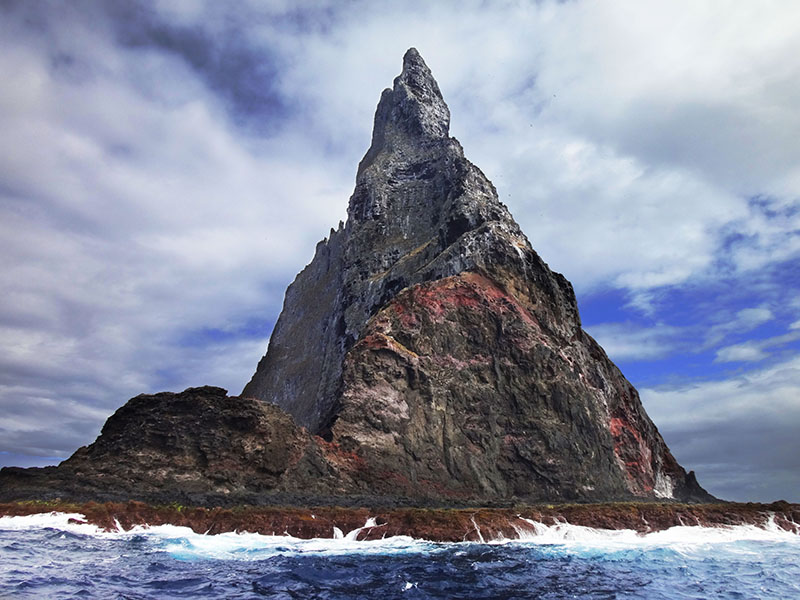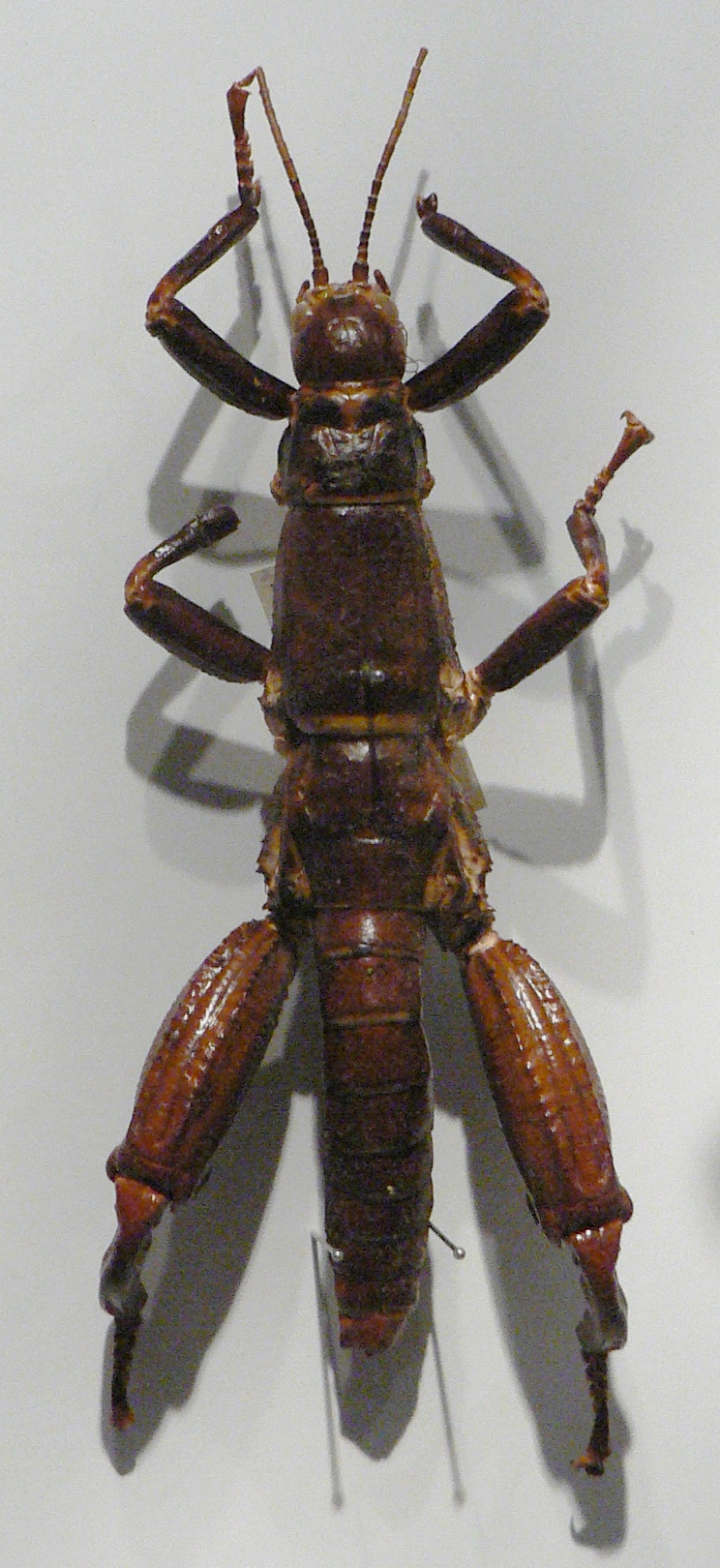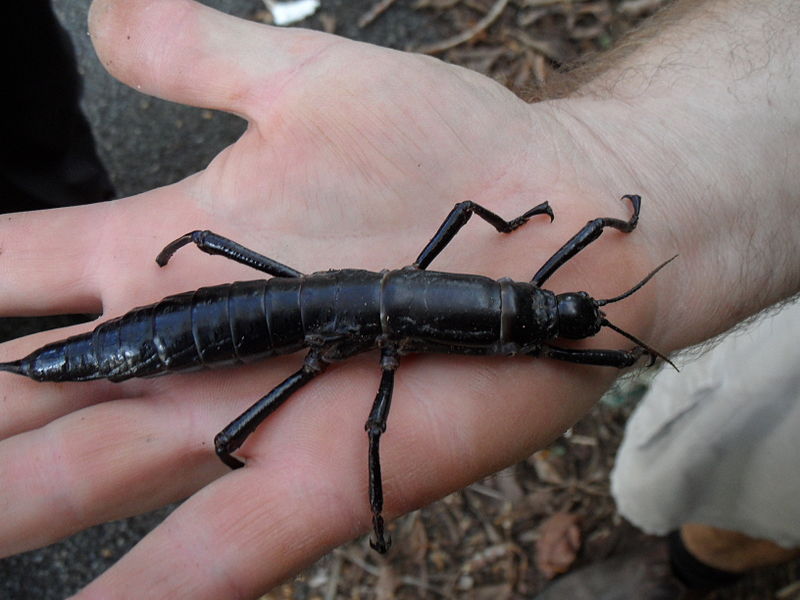Dryococelus australis Montrouzier, 1855
Lord Howe Island stick insect, Land lobster, Lord Howe Island phasmid, Giant Lord Howe Island stick insect
Taxonomy & Nomenclature
Synonyms: Karabidion australe Montrouzier, 1855 (original combination?); Karabidion australis Montrouzier, 1855; Carabidion australe Montrouzier, 1855; Eurycantha australe Montrouzier, 1855; Eurycantha australis Montrouzier, 1855; Eubulides spuria Kirby, 1904; Phasmid drycelus australis Montrouzier, 1855 (used by Cunningham, 2002:97)
Conservation Status
Last record: 1920
Rediscovered: 1968 or 1969 (dead specimens); 2001 (live specimens)
IUCN RedList status: Critically Endangered
- They were transported to Ball's Pyramid by fisherman who wanted a fresh and constant supply closer than LHI.
- They were transported there by birds, and somehow a few survived within a timeframe that allowed multiple mature individuals to mate and produce a viable population.
-
They were blown there by a cyclone, or other strong winds.
Distribution
Lord Howe Island and Ball's Pyramid, New South Wales, Australia
Biology & Ecology
Lea (1916) noted a close association between Dryococelus australis and the longicorn beetle Agrianome spinicollis.
Hypodigm
Media

Above: Ball's Pyramid, within the Lord Howe Island Marine Park, where the species was rediscovered in 2001. Photo by PotMart186, taken on 8 March 2014 at 10:03AM. Released under a CC BY-SA 4.0 license. Source: Wikimedia Commons.

Above: photo of a preserved specimen held by the Melbourne Museum. Photo taken by Peter Halasz, on 25 March 2006 at 12:48PM. Released under a CC BY-SA 3.0 license. Source: Wikimedia Commons.

Above: a captive Lord Howe Island stick insect. Photo taken by Granitethighs on 10 June 2011. Released under a CC BY-SA 3.0 license. Source: Wikimedia Commons.
References
Original scientific description:
Montrouzier, X. (1855). Essai sur la faune del'ile de Woodlark ou Moiou. Annales De La Societé D'Agriculture De Lyon 7: 1-114.
Other references:
Allen, Joanne L., Doidge, N. P., Cheng, C., Lynch, M., Crabb, H. K., Scheerlinck, J-P. et al. (2022). Genomic characterisation of an entomopathogenic strain of Serratia ureilytica in the critically endangered phasmid Dryococelus australis. PLoS ONE 17(4): e0265967. https://doi.org/10.1371/journal.pone.0265967
American Museum of Natural History and Levon Biss (photographer). (2023). Extinct & Endangered: Insects in Peril. ABRAMS. 144 pp.
ANZECC Endangered Fauna Network. (2002). Dryococelus australis. In: IUCN 2012. IUCN Red List of Threatened Species. Version 2012.1. (http://www.iucnredlist.org). Downloaded on 26 August 2012.
Australian Geographic. (2017). Australia Gone Wild. Sydney: Australian Geographic.
Balderson, Rentz & Roach. (1998). Phasmatodea. In Zoological Catalog of Australia 23: 367.
Bayley, Christine et al. (2018). Pathological and Microbiological Study of Mortality in a Captive Breeding Colony of the Endangered Lord Howe Island Stick Insect (Dryococelus australis). Veterinary Pathology. DOI: 10.1177/0300985818766210
Brock. (1999). Amateur Entomologist 26:26, fig 14.
Brock & Hasenpusch. (2007). Studies on the Australian stick insects (Phasmida), including a checklist of species and bibliography 1570: 72.
Brock & Hasenpusch. 2009. The Complete Field Guide to Stick and Leaf Insects of Australia 19, 35, 74-75 figs.
Buckley, T. R., Attanayake, D. and Bradler, S. (2009). Extreme convergence in stick insect evolution: phylogenetic placement of the Lord Howe Island tree lobster. Proceedings of the Royal Society B: Biological Sciences 276(1659): 1055-1062.
Burton, Adrian. (2016). Staving off extinction. Frontiers in Ecology and the Environment 14(10): 580.
Carlile, N., Priddel, D. and Honan, Patrick. (2009). The recovery programme for the Lord Howe Island Phasmid (Dryococelus australis) following its rediscovery. Ecological management & restoration 10(s1): S124-S128. [Abstract]
Cassis, Gerasimos. (2017). Conservation Biology: A Walking Stick’s Redux on Lord Howe Island. Current Biology 27(20): R1120-R1122. [Abstract]
Cleave, Rohan and Tulloch, Coral. (2015). Phasmid: Saving the Lord Howe Island Stick Insect. Clayton South: CSIRO Publishing. [Google preview]
Cox. (2005). PSG Newsletter 102:8, figs.
Cunningham, Antona (manag. ed.). (2002). Guinness World Records 2002. Jim Pattison Group. 288 pp.
Department of Environment and Climate Change (NSW). (2007). Lord Howe Island Biodiversity Management Plan Appendices. Department of Environment and Climate Change (NSW), Sydney. vii + 267 pp.
Egerton & Lochman. 2009. Wildlife of Australia 367.
Etheridge, R. (1889). The general zoology of Lord Howe Island; containing also an account of the collections made by the Australian Museum Collecting Party, Aug.–Sept., 1887. Australian Museum Memoir 2(1): 1-42, plates iv-v.
Freelance, Christopher B., Magrath, Michael J. L., Elgar, Mark A. and Wong, Bob B. M. (2022). Long-term captivity is associated with changes to sensory organ morphology in a critically endangered insect. J Appl Ecol. 59: 504-513.
Garnett, Stephen T., Latch, Peter, Lindenmayer, David B. and Woinarski, John C. Z. (eds.). (2018). Recovering Australian Threatened Species: A Book of Hope. CSIRO Publishing. 360 pp.
Gurney, A. B. (1947). Notes on some remarkable Australasian walkingsticks, including a synopsis of the genus Extatosoma (Orthoptera: Phasmatidae). Annals of the Entomological Society of America 40(3): 373-396. [Abstract]
Henderson, A., D. Henderson & Sinclair. 2008. Bugs alive: a guide to keeping Australian invertebrates 86, fig.
Hennemann, F. and Conle, O. (2006). Papuacocelus papuanus n.gen., n.sp. – a new Eurycanthinae from Papua New Guinea, with notes on the genus Dryococelus Gurney, 1947 and description of the egg (Phasmatodea: Phasmatidae: Eurycanthinae). Zootaxa 1375: 31-49.
Honan, Patrick. (2007a). Husbandry of the Lord Howe Island Stick Insect. Australasian Regional Association of Zoos and Aquaria, Melbourne.
Honan, Patrick. (2007b). The Lord Howe Island Stick Insect: an example of the benefits of captive management. The Victorian Naturalist 124(4): 258-261. [Abstract]
Honan, Patrick. (2007c). Butterfly & Other Invertebrates Club Inc. Newsletter 45:13, figs.
Honan, Patrick. (2008a). Notes on the biology, captive management and conservation status of the Lord Howe Island Stick Insect (Dryococelus australis) (Phasmatodea). Insect Conservation and Islands 2008: 205-219. [Abstract]
Honan, P. (2008b). Notes on the biology, captive management and conservation status of the Lord Howe Island Stick Insect (Dryococelus australis) (Phasmatodea) J. Insect Conserv. 12(3-4): 399-413. [Abstract]
Honan, Patrick, Cleave, Rohan, Dowsett, Norman, Anderson, Robert and Marston, Zoe. (2007?). Husbandry Manual for the Lord Howe Island Stick Insect. Published? Unpublished? [online version lacks appendices, "Contact invertebrates@zoo.org.au to obtain full version"]
Humphrey, M. (2001). Sticks in the press – encore. Phasmid Study Group Newsletter 87: 6.
Key. (1970). The Insects of Australia, A textbook for students and research workers. 1st Edition, p 358.
Kirby, W. F. (1896). On some new or rare Phasmidae in the collection of the British Museum, Transactions of the Linnean Society 2(6):447-475. [relevant citation?]
Kirby. (1904). [description of Eubulides spuria]. Ann. Mag. Nat. Hist. (7)13: 441.
Lea, Arthur M. (1916). Notes on the Lord Howe Island phasma, and on an associated longicorn beetle. Transcactions and Proceedings of the Royal Society of South Australia 40: 145-147.
Lonsdale. 2010. ICN 61:5.
Macey, R. (2001). Joy as ancient 'walking sausage' found alive. Sydney Morning Herald 13 Feb, 2001.
Mantle, Beth. (2013). Australian endangered species: Lord Howe Island stick insect. The Conversation, 24 January, available online: https://theconversation.com/australian-endangered-species-lord-howe-island-stick-insect-11789
McAlpine, D. K. (1967). Rediscovery of the Lord Howe Island phasmid. Australian Entomological Society News Bulletin 2(3): 71-72.
McGrath, Sarah J.,Cleave, Rohan J., Elgar, Mark A., Silcocks, Sarah C. and Magrath, Michael J. L. (2017). Determining host plant preferences for the critically endangered Lord Howe Island stick insect (Dryococelus australis) to assist reintroduction. Journal of Insect Conservation. https://doi.org/10.1007/s10841-017-0002-3 [Abstract]
McMichael, Donald F. (1967). The conservation of animals and plants. Australian Natural History 15(12): 423-428.
Mikheyev, Alexander S. et al. (2017). Museum Genomics Confirms that the Lord Howe Island Stick Insect Survived Extinction. Current Biology 27(20): 3157-3161.
Otte & Brock. (2005). Phasmida Species File. Catalog of Stick and Leaf Insects of the world 131
Pain, S. (2006). Return of the giants. New Scientist 191: 42-45.
Paramonov, S. J. (1963). Lord Howe Island, a riddle of the Pacific, part III. Pacific Science 17: 361-373.
Pearson, Elissa L. et al. (2022). Can we save Australia’s endangered wildlife by increasing species recognition? Journal for Nature Conservation 69: 126257. https://doi.org/10.1016/j.jnc.2022.126257
Priddel, D. and Carlile, N. (2010). In Soorae [Ed.]. Global re-introduction perspectives: 2010. Additional case-studies from around the globe 17.
Priddel D, Carlile N, Humphrey M, Fellenberg S, Hiscox D. (2002). Interim recovery actions: the Lord Howe Island Phasmid Dryococelus australis. NSW National Parks and Wildlife Service unpublished report, Sydney, Australia.
Priddel, D., Carlile, N., Humphrey, M., Fellenberg, S. and Hiscox, D. (2003). Rediscovery of the ‘extinct’ Lord Howe Island stick-insect (Dryococelus australis (Montrouzier)) (Phasmatodea) and recommendations for its conservation. Biodiversity and Conservation 12(7): 1391-1403.
Rainbow. (1897). Records of the Australian Museum, Sydney 3:38.
Redtenbacher. (1908). Die Insektenfamilie der Phasmiden. III. Phasmidae Anareolatae (Phibalosomini, Acrophyllini, Necrosciini). 3: 340.
Rentz. (1996). Grasshopper country. The abundant orthopteroid insects of Australia. 249, figs., 256.
Robertson, H. (2006). Sticking in there. Current Biology 16: R781-R782.
Sharp. (1898). In Willey. Zoological Results 2 274, fig. 160.
Silcocks, S., and Magrath, M.J.L. (2014). Morphological comparison of Lord Howe Island Stick Insects originating from the Ball’s Pyramid population and the extinct Lord Howe Island population. https://www.aesconferences.com.au/wp-content/uploads/2012/10/Poster-program-with-numbers-2014-9-Sept.pdf
Smith, M. (2012). PSG Newsletter 128:26, figs.
Smith, M. (2012). PSG Newsletter 129:35, figs.
Smithers, Courtenay N. (1969). On some remains of the Lord Howe Island phasmid (Dryococelus australis (Montrouzier)) (Phasmida) from Ball's pyramid. Entomology Monthly Magazine 105: 252. [published in 1970?]
Smithers, Courtenay N., McAlpine, David, Colman, Phil and Gray, Michael. (1974). Island Invertebrates. Australian Natural History 18(2): 60-63.
Stuart, Oliver P., Cleave, Rohan, Magrath, Michael J. L. and Mikheyev, Alexander S. (2023). Genome of the Lord Howe Island Stick Insect Reveals
a Highly Conserved Phasmid X Chromosome. Genome Biol. Evol. 15(6). https://doi.org/10.1093/gbe/evad104
Tepper, J. G. O. (1902). List of the described genera and species of the Australian and Polynesian Phasmidæ (Spectre-Insects). Transactions and Proceedsings and Report of the Royal Society of Southern Australia 26: 278-287. [284]
Vickery. (1983). CSIRO Australian division of Entomology, Technical Paper No 20, p. 6.
Westwood. (1859). Catalogue of the orthopterous insects in the collection of the British Museum. Part I. Phasmidae. 65, pl. 1:1-2.
Wilkinson, Rick. (2014). Return of the Phasmid: Australia's rarest insect fights back from the brink of extinction. Hamilton Central: Media Dynamics. 150 pp.
http://chinese.eurekalert.org/en/featured/story.php?story=20081217.ScienceNOW [incorrect disappearance timeline]
http://www.zoo.org.au/melbourne/animals/lord-howe-island-stick-insect
https://blog.csiro.au/childrens-book-reveals-how-phasmids-escaped-extinction/
http://extinctanimals.proboards.com/thread/13221/dryococelus-australis-island-stick-insect
http://www.rememberthewild.org.au/stuck-on-a-rock-rediscovering-the-lord-howe-island-stick-insect/
https://extinctandendangered.com/gallery/glaucopsyche-xerces
